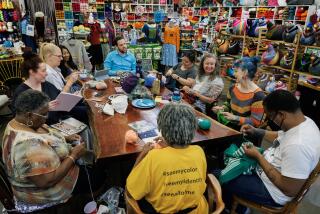The New-School Way to Heal the Body
- Share via
MINNEAPOLIS — In Room 4-180 of the University of Minnesota’s Weaver-Densford lecture hall, a student is prone on a padded table with four long needles protruding from her right calf.
Welcome to a medical school that has decided it’s time to teach students that Western medicine isn’t the only way to heal.
The guest lecturer--registered nurse and acupuncturist Colet Lahoz--examines the heart and small intestines by pressing her fingers on the left wrist of the student, who has complained of chronic leg pain. Lahoz finds “cold dampness” in the spleen and recommends “warming the channels and draining moisture” through acupuncture. If that fails, she instructs the students circling the table to look for a fungal or parasitic infection.
Meanwhile, a short distance across campus at Fairview-University Medical Center, Sister Mary Casey, a chaplain and licensed message therapist, has just conducted a guided imagery treatment with a patient and is relaxing now in a chapel-like room called the Meditation Place.
“I pick up things with my hands,” says Casey, explaining how a chaplain becomes a massage therapist. “I invite patients to breathe and I can connect with them. I was working with a woman recently who had a heart problem, and I asked her to visualize a shaw. She told me she had a dream the night before about a shaw.”
Casey shrugs. “I have a zillion stories like that.”
Elsewhere in the vast Academic Health Center, a study is underway to look at relaxation and guided imagery to ease chemotherapy. The head of a research clinic is studying whether a change in diet could reduce the need for high-blood-pressure medication. A class of medical students discusses the concept of a patient’s soul, and pharmacy students are conducting a study of herb use in the city’s large Vietnamese community.
All this activity falls under a year-old program called the Center for Spirituality and Healing that is garnering national attention for its plunge into alternative, or integrative, medicine.
While many medical schools are adding courses in alternative health, Minnesota is perhaps making the most serious effort at training students in a new model.
And, says Dr. James Gordon, clinical professor at Georgetown University School of Medicine, Minnesota’s alternative health program is “the most important effort that’s going on around the country because it is far-reaching, it is thoughtful, it is evidence-based, it is including a wide range of people in discussions.”
Gordon’s last point may be the most noteworthy. Not only is the University of Minnesota making changes on-campus, but it has connected with a most unlikely ally: the city’s world-class biomedical industry. On the Spirituality and Healing Center’s development board sits Earl Bakken, the inventor of the cardiac pacemaker who, now semi-retired from his company, Medtronic, has decided to devote his energies to nontechnological methods of healing.
“To me, it’s no surprise that all this has happened in Minnesota,” says Howard Bell, executive director of Pathways, a health crises resource center in Minneapolis that also has close ties to the university. “The hospice movement was always strong here. There have been liberal politicians, and the Minnesota AIDS program was among the earliest large AIDS organizations in the United States. Still, 10 years ago, we couldn’t have envisioned what they are doing at the university.”
The program began when Frank Cerra, senior vice president for health sciences, created a task force to explore complementary medicine in 1996.
“To change medical school curricula takes years. But we need to get physicians at a level now where they understand what is critical to know about alternative therapies,” says Mary Jo Kreitzer, director of the Center for Spirituality and Healing. “Medical students need to know enough to talk to patients, access data, evaluate research findings, make referrals and understand interdisciplinary teamwork.”
Typically at medical schools around the nation, alternative medicine is being taught by a single individual or two with grudging approval from a dean, says Dr. Patricia Muehsam, who heads the newly formed Assn. of American Medical Colleges task force on integrative medicine. She teaches a course at Mt. Sinai Medical School in New York.
“My course was an add-on,” Muehsam says. “It is not integrated into the curriculum. There is no budget for it. I’m a one-woman show. And I don’t believe this is optimal. The long-term goal [of the task force] is to reassess the meaning and intent of medical training and have an integrated curriculum.”
Alternative Approach Now Seen as Crucial
In a windowless classroom cut off from a glowing spring day, Dr. Gregory Plotnikoff’s class, Cultures, Faith Traditions and Health Care, is meeting with two ministers from the community. The chaplain presents a case in which a woman who had long battled infertility suffered a miscarriage five months into her pregnancy. In the hospital, the woman was encouraged to dress the stillborn baby, hold her and take pictures. The students discuss what they would have said when the patient asked: “Doctor, why did my baby have to die?”
“It’s OK to say, ‘I don’t know. This is very hard,’ ” Plotnikoff advises. “Spirituality is not about answers. It’s about living with questions.”
This is the kind of medical training that university leaders view as crucial to future doctors.
“If we are only looking at potassium levels, we are not going to see the whole patient,” says Plotnikoff. “We want to be able to address things beyond symptoms.”
Minnesota’s alternative medicine effort is led by a small, eclectic group of teachers that includes Plotnikoff, who earned a divinity degree at Harvard University before entering medical school.
“Then, when I went to medical school, I had different expectations of what medical school should be. I asked different questions,” he says.
According to Plotnikoff, physicians today should be capable of relating to patients beyond a physiological assessment.
“ ‘Doctor, why did my baby have to die?’ Questions like that are inherent in medicine,” he says. “Medical school teaches people to give literal answers, technical mumbo jumbo that completely misses the point of the question. My fervent hope is that the students at the University of Minnesota won’t be blind and deaf to these issues and won’t give inappropriate answers to these questions.”
While veteran physicians may find it tough to discuss guided imagery or herbs with patients, today’s medical student appears to yearn for a career beyond CAT scans, HMO dictates and prescription pads.
“Sometimes I get the feeling we are getting trained to be brokers for pharmaceutical companies when what we should be are healers,” says John Harmala, a third-year medical student from Minnesota.
There is evidence that students pursuing health careers today are more comfortable with such concepts as mind-body medicine and spirituality. One of the most popular electives in the medical school is to follow the chaplain around. The University of Minnesota defines spirituality not as religion but as helping people find “purpose, meaning and connection.”
“I’m guessing that previous generations of doctors had faith, and their spirituality kept them going. But there wasn’t freedom to acknowledge it,” says Sister Casey. “Things have changed. The trend in complementary medicine gives doctors new permission, but also new expectations. What if you’re a doctor and your patient asks, ‘Will you pray with me?’ There is a different kind of pressure on doctors. You still have to be a risk-taker to do this.”
Old Dogs, New Tricks and Applied Treatment
Minnesota’s alternative health program extends beyond training students. There are courses to retrain health professionals and alternative treatments are offered to patients in several integrated clinics on campus.
In the women’s clinic, Dr. Sharon Norling is meeting with a patient, Betty Fenna, 51. Late last year, Fenna came in to meet Norling complaining of a lifetime of migraine headaches and the failed treatments of dozens of neurologists. She carried with her a letter from a leading medical center that informed her: “There is very little we can do for a person like you.”
“I was hopeless that my life would ever be any better,” says Fenna.
Norling was not hopeless. “I knew there were other options we could offer her.”
Known for her expertise in non-Western therapies, Norling recommended acupuncture treatments, which almost immediately began to ease Fenna’s pain.
“I haven’t felt this good since I was a child,” Fenna says.
Norling is nonchalant.
“It’s so imperative that physicians keep an open mind and look at the research out there.” (She notes that some studies show acupuncture can be helpful in alleviating migraines.)
Community enthusiasm from patients like Fenna has led the university to begin construction of a new integrative health clinic called the Mind, Body and Spirit Clinic, which will open in the fall. In addition, Medtronic’s Bakken is honorary co-chair of an $8 million to $10 million development campaign to expand the Center for Spirituality and Healing.
Bakken’s involvement in the program sends a strong message to the community, says Kreitzer.
“It’s a paradox to have a biomedical engineer who totally understands mind-body medicine,” she notes.
Bakken invented the first implantable pacemaker in 1957 but eventually became disenchanted with modern medicine.
“I found that the pacemakers worked better in some doctors’ hands than in others,” he says. “I discovered the impact is how the doctor and nurse works with the patient’s body, mind and spirit. Even a good technician will have a poor result if they are working with just the body.”
Bakken is now devoted to integrative medicine at the University of Minnesota and the North Hawaii Community Hospital in Kamulea, Hawaii. In Kamulea, where he moved upon retiring from Medtronic, he founded the Five Mountain Community, a nonprofit advocacy group committed to improving health care and attracting a new type of “medical tourist” to the island for integrated health.
“You want to put the two together,” Bakken says. “Body, mind and spirit is what medicine was about before the scientific age. Good physicians know what their words can mean. It’s a failing of our health care system that we don’t have time for words at the bedside.”
*
ST. JOHN’S WORT
Do you get what you pay for when you buy the herb at a pharmacy? A1





